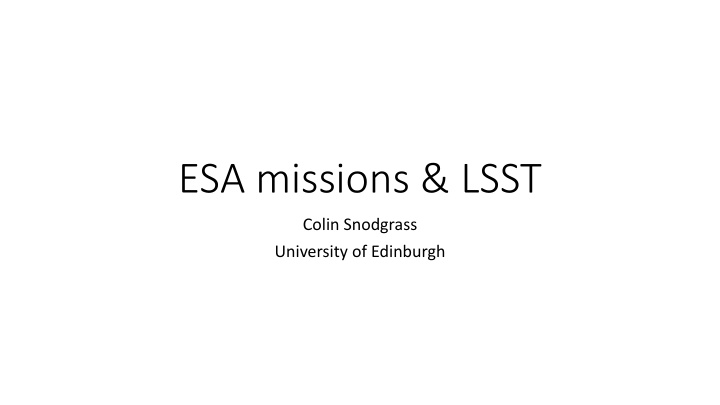



ESA missions & LSST Colin Snodgrass University of Edinburgh
Coming soon!
+ Plato + Ariel (exoplanets)
ESA missions in the LSST era • Only planetary missions that are approved are Juice and Comet Interceptor • Juice not really relevant for LSST (and vice versa) • Hera planetary defence mission might be interested in LSST Didymos observations • Astronomy missions: • Gaia and LSST powerful combination for astrometry • Euclid and LSST are both wide field imaging surveys operating at the same time
Solar System science with Euclid • Euclid is a cosmology mission • Measures dark matter/energy via lensing of distant galaxies • High resolution imaging over relatively wide field, 15,000 deg 2 survey • Visible + NIR channels • Avoids ecliptic plane • Still expect ~150k SSO observations, 99% new objects • Predictions & simulations: Carry 2018 (A&A) • There is now a SSO working group in Euclid
Euclid SSO observations
Euclid advantages • The NIR coverage of Euclid is much more diagnostic of mineralogy in rocky bodies than visible only surveys • Complementary to LSST visible colours • High spatial resolution also useful, KBO binaries will be resolved
Euclid challenges • Only one visit to each field, lasting ~1 hour • This gives only a very short arc to determine orbits • Length of trail gives some idea of distance (closer objects move faster) • In many (most?) cases the orbit of newly discovered objects will be completely unknown • Will we have ~real-time SSO pipeline for discovery alerts? • At fastest, will still have delay of ~days to downlink and process data • Discovered objects will be faint (V~24) and hard to recover. • Follow up would need a lot of 8m telescope time.
Euclid + LSST • Euclid will operate at the same time as LSST • LSST will discover vast numbers of SSOs • Many Euclid targets will also be seen (at some point) by LSST, allowing eventual linking of observations with orbits • This doesn’t necessarily apply to some of the most interesting objects (e.g. small NEOs, outbursting objects) • LSST will (eventually) get visible colours for most SSOs • Not all (again, small NEOs or things only seen for a short period) • Visible colours give only limited information • Simultaneous Euclid+LSST observations solve some of these problems
Parallel observations • LSST + Euclid have comparable sensitivity • Parallel observations from Earth and from Euclid (at L2) give measurable parallax for SSOs • Independent distance determination + sky motion from Euclid gives a reasonably constrained orbit • Enough to identify unusual / interesting objects for follow up • Additional LSST observations in usual pattern (e.g. 2 visits in a night, returning a few nights later) give decent orbit • We made the case for scheduling LSST observations in parallel with Euclid when possible in the recent call for LSST cadence white papers
Visibility of Euclid fields from LSST Euclid fields LSST fields (WFD survey)
Visibility of Euclid fields from LSST • Approx 8% of Euclid fields observable in parallel from Chile • 3,489 pointings over 6 years • Compared to planned ~1000 / night for LSST • elevation > 30 ◦ • ~half of these are observable with both Sun and Moon distances > 90 ◦ • ~280 fields are observable during each of the three twilights (civil, nautical, astronomical).
Comet Interceptor is a mission targeting a dynamically- new comet, or an interstellar object. Why? • All previous comet missions have been to objects that have passed the Sun many times • Targets were relatively evolved, with thick coatings of dust on their surfaces • A dynamically-new comet (DNC) is one that is probably nearing the Sun for the first time • A mission to a DNC would encounter a pristine comet, with surface ices as first laid down at the Solar System’s formation
Comet Interceptor Mission Profile • Mission ‘parked’ at stable Lagrange point L2 after launch with Ariel • Waits for up to 2-3 years for new target discovery by a ground-based observatory (probably LSST) • Short cruise and fast flyby of target comet near Earth’s distance from the Sun • Comet Interceptor has three parts: • Mothership (Spacecraft A) with remote sensing payload, distant ‘safe’ flyby (~1000 km), provides propulsion and communications with Earth • Released sub-spacecraft (B1 and B2) take instruments on different trajectories through coma, including much closer to nucleus
Mission is enabled by LSST • The only way to encounter a DNC is to discover it inbound with enough warning to direct a spacecraft to it • The likelihood of this happening will soon be greatly increased by LSST • LSST will increase the distance at which DNCs discovered inbound • Comets expected to be found at ~20 AU • This implies warning times of > 5 years • May well know target before launch • But not before design has to be frozen M. Królikowska & P. A. Dybczynski 2019, arXiv 1901.01722
Conclusions • Euclid + LSST have complementary capabilities for SSOs • Euclid observed SSOs will often be of rare and interesting types • Parallel LSST observations will make sure that newly identified objects in Euclid fields are not lost, as parallax allows preliminary orbit from single visit • LSST cadence white paper: http://arxiv.org/abs/1812.00607 • Comet Interceptor will go to a yet-to-be-discovered comet; LSST expected to discover this comet at large heliocentric distance • More info at www.cometinterceptor.space or @cometintercept
Recommend
More recommend